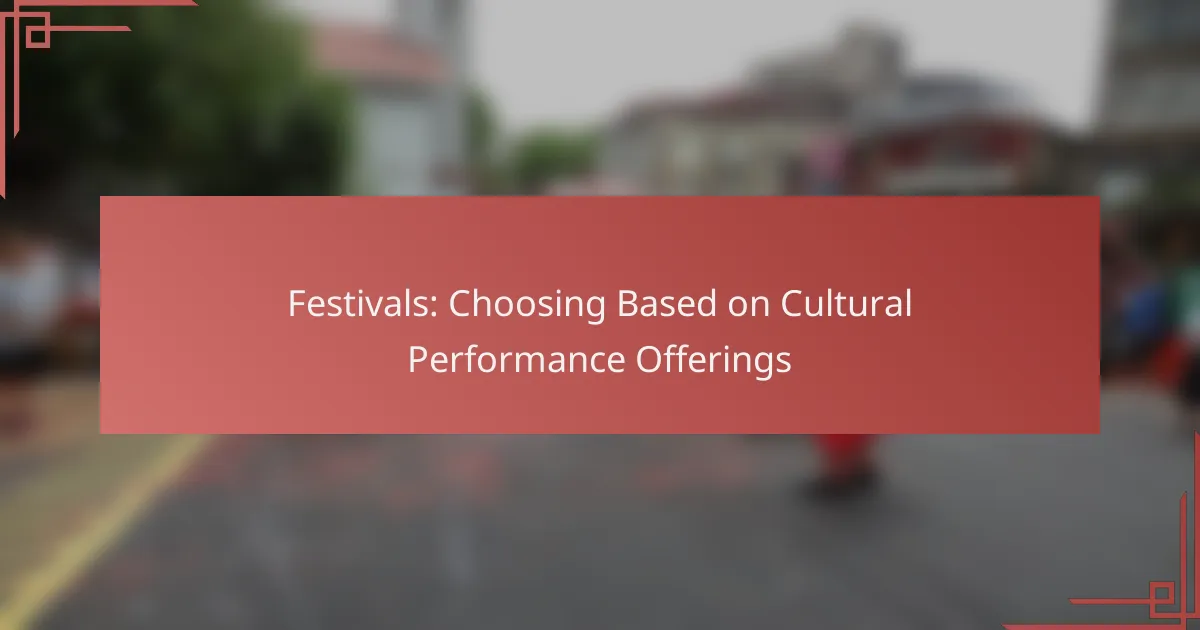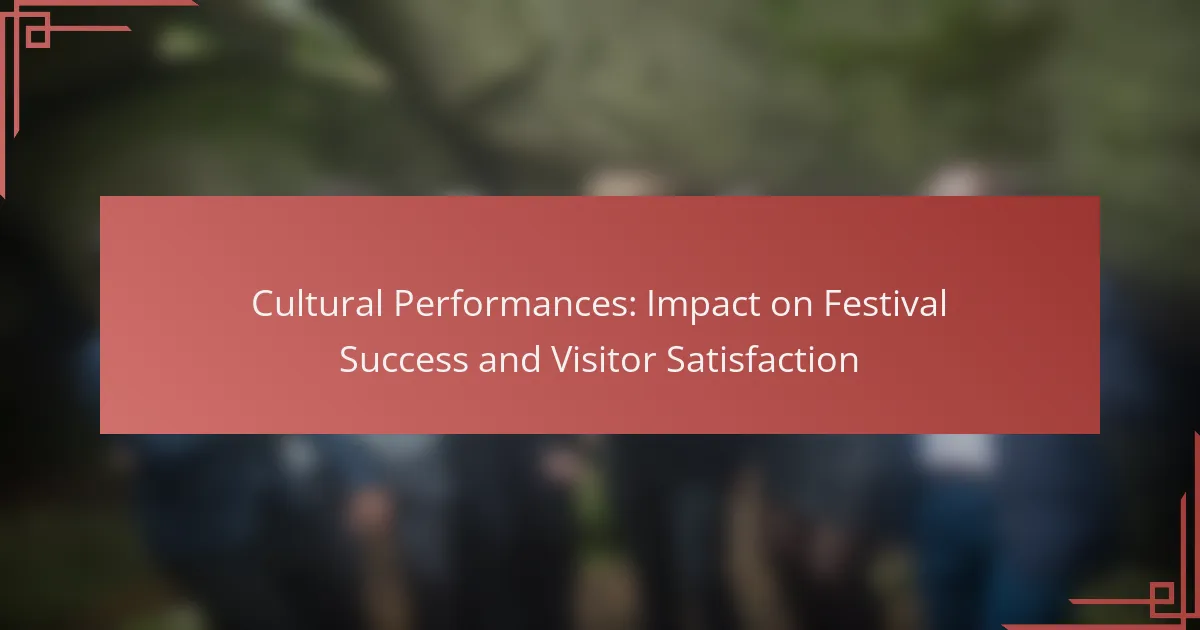Festivals across the United States offer a vibrant array of cultural performances that celebrate diverse artistic traditions. Events such as the New Orleans Jazz & Heritage Festival and the San Francisco Ethnic Dance Festival provide unique opportunities for attendees to engage with and appreciate the richness of various cultures through music, dance, and art.

Which festivals offer the best cultural performances in the United States?
Several festivals in the United States are renowned for their exceptional cultural performances, showcasing a variety of artistic traditions. Notable events include the New Orleans Jazz & Heritage Festival, the Chicago Blues Festival, the San Francisco Ethnic Dance Festival, the Philadelphia Folk Festival, and the Los Angeles County Fair, each offering unique experiences that highlight their respective cultural heritages.
New Orleans Jazz & Heritage Festival
The New Orleans Jazz & Heritage Festival, often referred to as Jazz Fest, celebrates the music and culture of New Orleans and Louisiana. Held annually in late April to early May, it features a diverse lineup of jazz, blues, gospel, and traditional Louisiana music, attracting hundreds of thousands of visitors.
Attendees can enjoy performances from both legendary artists and emerging talents across multiple stages. In addition to music, the festival showcases local cuisine, crafts, and cultural exhibits, making it a comprehensive celebration of the region’s heritage.
Chicago Blues Festival
The Chicago Blues Festival is the largest free blues festival in the world, typically held in June. This festival honors the rich history of blues music, which originated in Chicago, and features performances from top blues musicians, both local and international.
Visitors can expect to see a variety of blues styles, from traditional to contemporary. The festival also includes workshops and discussions, providing insights into the genre’s impact on music and culture.
San Francisco Ethnic Dance Festival
The San Francisco Ethnic Dance Festival, occurring annually in June, showcases the diverse dance traditions of various cultures. This festival highlights performances from a wide array of ethnic groups, offering a platform for both established and emerging artists.
With performances ranging from African and Asian to Latin and Native American dance, attendees can experience a rich tapestry of cultural expressions. The festival also includes workshops, allowing participants to learn about the dances and their cultural significance.
Philadelphia Folk Festival
The Philadelphia Folk Festival is one of the longest-running folk festivals in the country, typically held in August. It features a mix of folk, bluegrass, and Americana music, with performances from both renowned artists and local talent.
This festival not only focuses on music but also emphasizes community and cultural exchange, offering workshops, crafts, and food from various cultures. It’s a great opportunity for attendees to immerse themselves in folk traditions and connect with artists.
Los Angeles County Fair
The Los Angeles County Fair, held annually in September, includes a variety of cultural performances alongside traditional fair attractions. While it features rides and exhibits, the fair also showcases music and dance from different cultures, reflecting the diversity of the Los Angeles area.
Attendees can enjoy performances ranging from mariachi and hip-hop to country and rock, making it a family-friendly event that appeals to a wide audience. The fair also offers food from various cultural backgrounds, enhancing the overall experience.
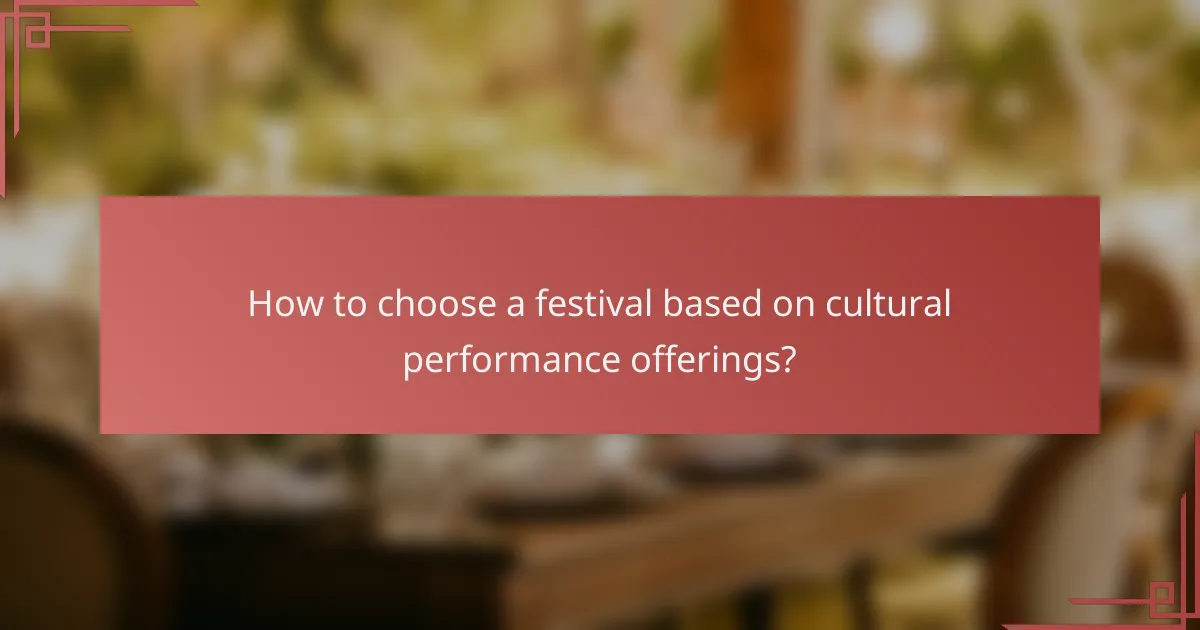
How to choose a festival based on cultural performance offerings?
Choosing a festival based on cultural performance offerings involves evaluating the variety, engagement, and accessibility of the performances. A well-rounded festival will feature diverse acts that cater to different interests and provide an immersive experience for attendees.
Evaluate performance diversity
Assessing performance diversity is crucial for selecting a festival that meets your cultural interests. Look for festivals that showcase a range of artistic expressions, such as music, dance, theater, and visual arts. A diverse lineup can enhance your experience by exposing you to various cultures and styles.
Consider festivals that feature both local and international artists, as this can provide a richer cultural tapestry. For instance, a festival that includes traditional folk performances alongside contemporary art can appeal to a broader audience.
Consider audience engagement
Audience engagement is a key factor in the overall enjoyment of a festival. Look for events that offer interactive performances, workshops, or opportunities for attendees to participate. Engaging performances can create memorable experiences and foster a deeper connection to the art.
Check if the festival includes Q&A sessions, meet-and-greets with performers, or hands-on activities. These elements can significantly enhance your understanding and appreciation of the cultural offerings.
Assess location and accessibility
The location and accessibility of a festival can greatly influence your decision. Consider how easy it is to reach the venue, including transportation options and parking availability. Festivals in urban areas may offer better public transport links, while rural festivals might provide a unique setting but require more planning to access.
Additionally, check for facilities that accommodate all attendees, such as wheelchair access and restrooms. Ensuring that the festival is accessible can enhance the experience for everyone involved.

What are the key attributes of cultural performances at festivals?
Cultural performances at festivals are defined by their artistic quality, authenticity of cultural representation, and variety of genres. These attributes significantly enhance the festival experience, providing attendees with a deeper understanding and appreciation of diverse cultures.
Artistic quality
The artistic quality of cultural performances is crucial as it reflects the skill and creativity of the artists involved. High-quality performances often feature well-trained performers, intricate choreography, and impressive production values, which can elevate the audience’s experience. Look for festivals that showcase award-winning artists or have received accolades for their performances.
When evaluating artistic quality, consider factors such as the reputation of the performers, the complexity of the art form, and audience reviews. Engaging performances often leave a lasting impression and can be a highlight of the festival.
Authenticity of cultural representation
Authenticity in cultural representation ensures that performances genuinely reflect the traditions and values of the culture being showcased. This can involve using traditional costumes, instruments, and storytelling methods that accurately represent the culture’s heritage. Festivals that prioritize authenticity often collaborate with cultural experts or local communities to ensure respectful and accurate portrayals.
To assess authenticity, research the background of the performances and the artists. Look for festivals that emphasize cultural education and engagement, as these often provide a more genuine experience for attendees.
Variety of genres
A diverse range of genres in cultural performances enriches the festival experience by appealing to different tastes and interests. Festivals that feature a mix of music, dance, theater, and visual arts allow attendees to explore various cultural expressions. This variety can attract a broader audience and encourage cross-cultural appreciation.
When choosing a festival, consider the genres represented and whether they align with your interests. Festivals that offer workshops or interactive sessions in addition to performances can provide an even more immersive experience, allowing attendees to engage with the art forms directly.
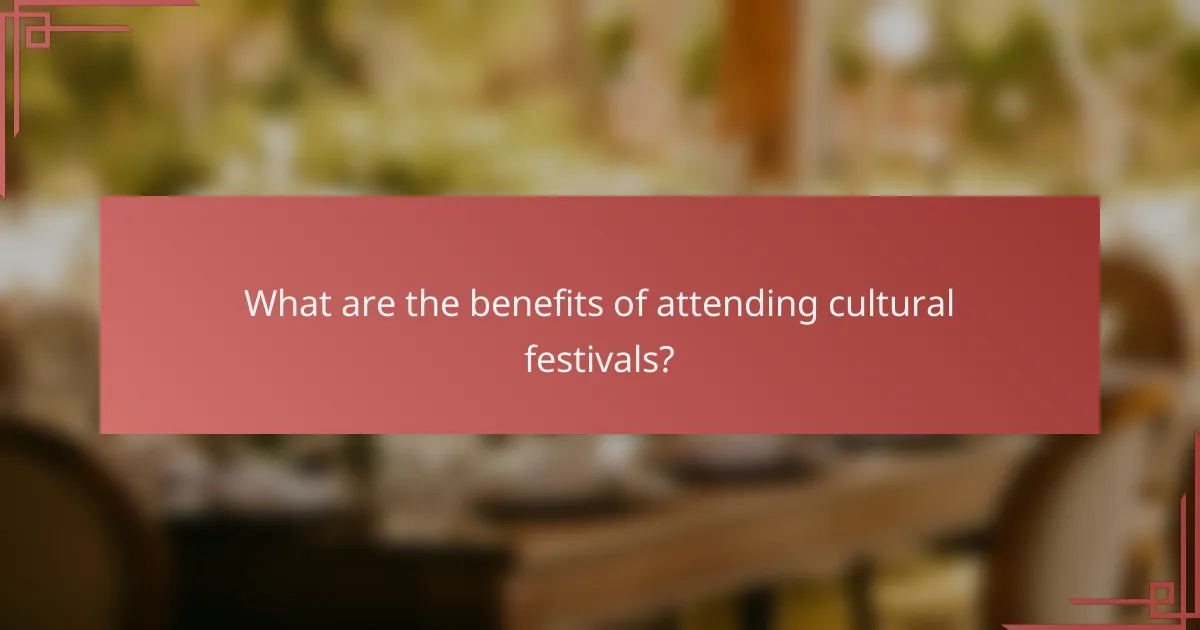
What are the benefits of attending cultural festivals?
Attending cultural festivals offers numerous benefits, including the chance to experience diverse traditions and connect with communities. These events not only enrich personal understanding but also foster social interactions and support local economies.
Exposure to diverse cultures
Cultural festivals provide a unique opportunity to immerse oneself in different traditions, languages, and art forms. Participants can enjoy performances, food, and crafts that reflect the heritage of various communities, enhancing cultural appreciation.
For example, festivals celebrating Hispanic, Asian, or Indigenous cultures often feature traditional music, dance, and cuisine, allowing attendees to experience these cultures firsthand. This exposure can lead to greater empathy and understanding among diverse groups.
Opportunities for networking
Attending cultural festivals can facilitate valuable networking opportunities, especially for artists, performers, and community leaders. These events attract individuals from various backgrounds, creating a space for collaboration and idea exchange.
Engaging with others at these festivals can lead to partnerships, mentorships, or even job opportunities. For instance, artists may find potential collaborators or sponsors while festival-goers can connect with local businesses and organizations.
Support for local artists
Cultural festivals often serve as a platform for local artists to showcase their work, helping to sustain and promote their crafts. By attending these events, participants contribute to the local economy and encourage the continuation of traditional art forms.
Purchasing artwork, crafts, or food directly from artists at festivals ensures that a larger portion of the proceeds supports the creators. This not only aids individual artists but also strengthens the cultural fabric of the community.
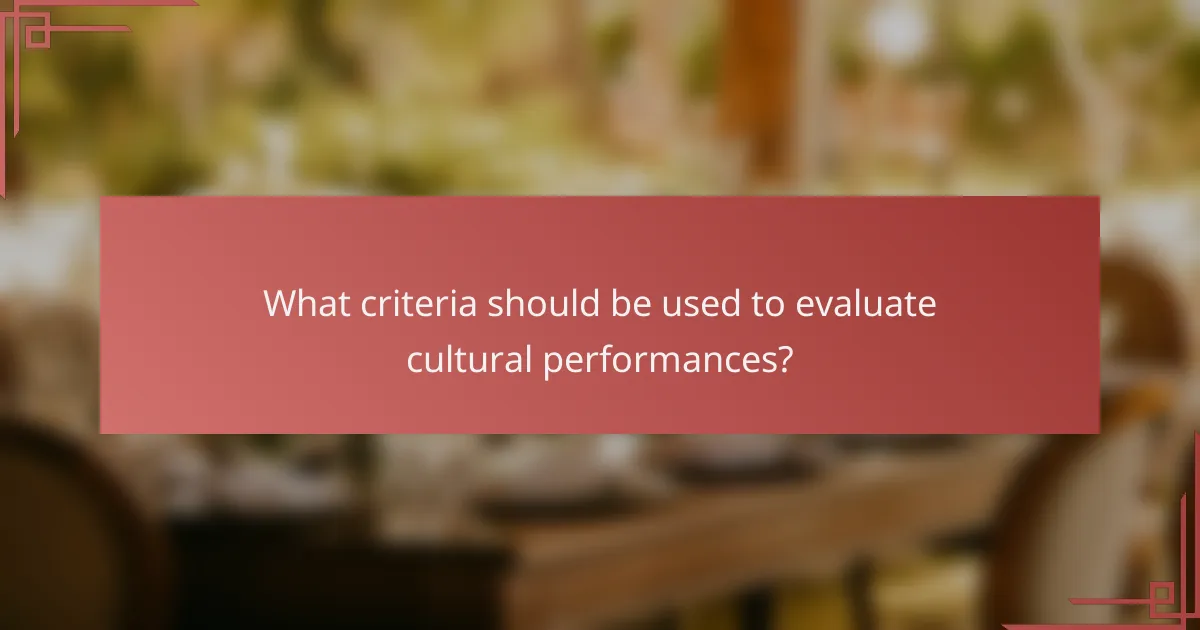
What criteria should be used to evaluate cultural performances?
When evaluating cultural performances, consider factors such as artistic merit, audience reviews, and historical significance. These criteria help gauge the quality and impact of the performances, ensuring a well-rounded assessment.
Artistic merit
Artistic merit refers to the quality and creativity of the performance, including elements like choreography, music composition, and visual aesthetics. Look for originality and technical skill, as these aspects often indicate a higher level of artistry.
Consider the reputation of the artists involved and any awards or recognitions they may have received. Performances that showcase innovative techniques or unique interpretations of traditional forms generally stand out.
Audience reviews
Audience reviews provide insight into the reception of a performance, reflecting the emotional and intellectual engagement of viewers. Check platforms like social media, review sites, or local forums to gather a range of opinions.
Pay attention to common themes in the feedback, such as the effectiveness of storytelling or the impact of the performance on the audience. High ratings and positive comments can indicate a successful cultural experience.
Historical significance
Historical significance assesses how a performance connects to cultural heritage and societal narratives. Consider whether the performance reflects important traditions, events, or movements within a culture.
Research the background of the performance and its relevance to contemporary issues or historical contexts. Performances that resonate with current societal themes or revive forgotten traditions often hold greater importance.
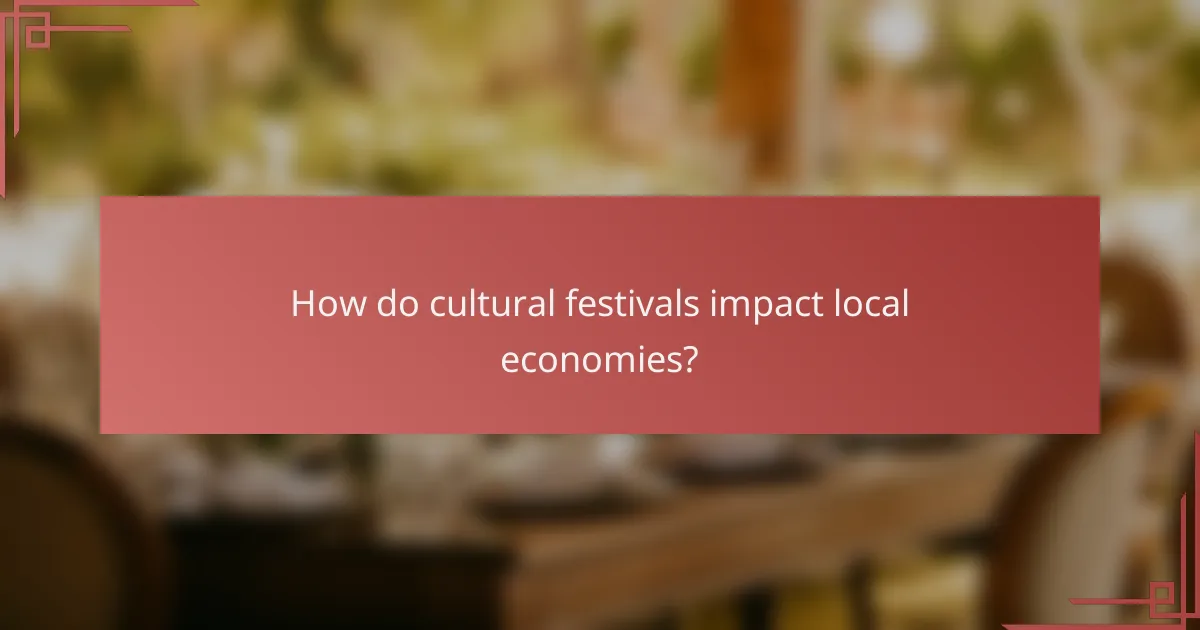
How do cultural festivals impact local economies?
Cultural festivals significantly boost local economies by attracting visitors and increasing spending in various sectors. These events create opportunities for local businesses, enhance community engagement, and can lead to long-term economic benefits.
Increased tourism revenue
Cultural festivals draw tourists, which directly contributes to increased tourism revenue. Visitors spend money on accommodations, dining, transportation, and entertainment, benefiting local businesses and generating tax income for municipalities.
For example, a festival attracting thousands of attendees can lead to a significant spike in hotel bookings and restaurant sales. In many cases, local economies can see revenue increases ranging from tens of thousands to millions of dollars during peak festival periods.
To maximize tourism revenue, festival organizers should promote events through targeted marketing strategies, including social media campaigns and partnerships with local businesses. Offering packages that combine festival tickets with local attractions can also enhance visitor experience and spending.
